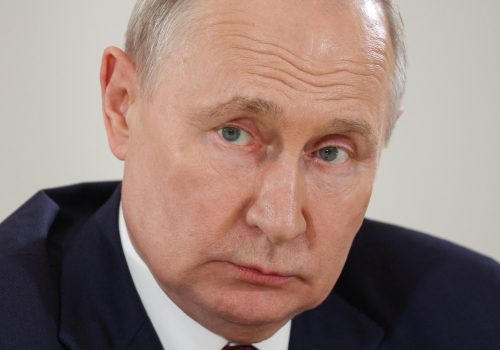The West won’t seize Russia’s reserves any time soon. Here’s what it can do with the funds instead.
For eighteen months, half of Russia’s six hundred billion dollars in foreign exchange reserves have been out of the Kremlin’s reach. The coordinated blocking by Group of Seven (G7) powers and like-minded capitals has worked to this extent. But the debate concerning how to put the funds to good use remains unresolved. Influential voices have called for Ukraine to use the funds for its reconstruction. No executive branch has been convinced yet.
Arguments in favor of giving the money to Ukraine are often well-put and compelling. But so are the counterarguments, which officials voice, usually but not only off the record. On Wednesday, US Treasury Secretary Janet Yellen hinted she still has strong doubts about such a measure as she mildly endorsed alternative proposals under discussion in the European Union (EU). European Central Bank President Christine Lagarde has also expressed skepticism that such a measure can be taken without affecting the financial stability of the eurozone—which is where most of the money is stored.
The oft-invoked precedent after the First Gulf War, when in 1992 Iraqi assets were allocated to Kuwait and other offended parties, was approved unanimously by the United Nations Security Council. No such legal cover will be available now. At the time, the international community was also keen to distinguish between income Iraq had earned since the beginning of the war and earlier earnings. Policy should not be bound by precedent, but the distinction is important. Russia amassed its reserves by selling oil and gas that the entire West was happy to buy. No court will confirm that the reserves are ill-gotten gains, so that avenue for seizing them—which can be used for some oligarchs’ assets—is closed. Finally, when the George W. Bush administration seized $1.7 billion of Iraqi assets held in the United States in 2003, the country was at war with Iraq. No matter what Russian propagandists say, Western support for Ukraine does not mean it is a co-belligerent with Ukraine.
What other options are available? Canada is sometimes lauded as the trailblazer of an experiment that might ultimately lead to Russian state assets being committed to Ukraine’s reconstruction. However, the amendments to Canada’s Special Economic Measures Act (SEMA) that have been voted through since Russia’s February 2022 invasion merely provide a process for using the proceeds from forfeited assets to fund Ukraine’s reconstruction. The amendments do not mention sovereign assets, which the Canadian government has been just as prudent as its peers in dealing with.
With a multilateral approach out of the question, then, some argue a unilateral approach supported by changes to domestic law should suffice. There are clear risks to doing this, however. Except for leaving Ukraine and paying for the damage it has caused, Russia can do very little to end the temporary immobilization of its assets. But it would almost certainly sue for its money if it were seized. If any court (and there are many to choose from) rules in its favor, a sympathetic third country could technically recoup US or European funds flowing through its jurisdiction on Russia’s behalf. Ironically, such legal uncertainty has loomed over Russia since 2015, when the Permanent Court of Arbitration in The Hague ruled that the Russian state owed shareholders of the Russian oil and gas company Yukos fifty billion dollars. The judgment has since been cancelled by the Dutch Supreme Court, but only to be returned to a lower court for further deliberations—and more uncertainty.
The economic counterarguments are not overdone either. Immobilizing Russia’s reserves was already a risk and seizing them would be a much more radical step. Foreign exchange reserves are still the strongest pillar of the global financial safety net, simply in terms of volume. This safety net relies on states that are not allies storing value with each other. The United States is an exception to the rule, as its foreign exchange reserves are stored exclusively in euros and Japanese yen.
Summarizing the arguments that are voiced off the record in the executive branch of G7 governments should at least tell us this: The West is unlikely to seize Russia’s reserves any time soon. We should ask ourselves what can be done for Ukraine instead.
Know a good investment when you see it
Europe has done much more work on the issue of blocked central bank reserves than the United States or Japan has. A self-reporting deadline set by the European Commission for March 2023 revealed that a pile of cash was growing in Euroclear as the coupon and principal payments on safe government bonds bought by the Russian central bank came in and sanctions prevented Euroclear from crediting these to the central bank’s cash account. Over time, up to $210 billion could be caught in this way. So far, it has already tripled Euroclear’s balance sheet and allowed it to earn interest on this cash by depositing it in eurozone central banks. Acknowledging the positive effect this has had on Euroclear’s profits, and therefore on the tax it owes, the Belgian government has made additional financial commitments to Ukraine to the tune of a hundred million euros.
Useful though it may be, one hundred million euros is a drop in the ocean compared to the three hundred billion dollars at stake. Much more can be done beyond taxing Euroclear’s windfall profits.
In March, a well-publicized leak from the European Commission revealed that thinking inside the European Union (EU) about what more can be done was advancing. As the pile of money grows, the leaked documents outlined, it could be invested much more profitably, with the goal of creating an annuity for Ukraine of at least two billion dollars a year. Recent reports, however, suggest member states are dragging their feet on this plan, preferring a staggered approach that would first implement strict balance sheet rules with a separate column for immobilized reserves. But there is no need for this step; Euroclear has already done this.
In such a high-interest-rate environment, it would be a terrible shame to miss such an opportunity to invest the money. Of course, concerns for the precedent this would create also exist. The EU or any other power taking this step would notionally have to compensate Russia should the investments that are made lose value. Regarding private property, some fear that such a move would pit the EU against Euroclear shareholders. In this very special case, however, it’s hard to see why the collective of large European banks and governments would not make a generous exception for Ukraine.
Following Europe’s example
Even though we know what we know thanks to a leak, credit is still due to the EU—and to the United Kingdom, whose gilts are also managed through the Euroclear system—for achieving a relatively direct understanding of where the money is blocked and what options are available.
Sadly, much less is known publicly of US and Japanese efforts to match this effort. The entire sanctions-wielding coalition coordinates on this issue via the Russian Elites, Proxies, and Oligarchs (REPO) Task Force. Only last week, the task force announced it has “completed” its first stab at mapping immobilized sovereign assets. They have collectively found $280 billion—just short of the approximately $310 billion which was stored in the sanctions-wielding jurisdictions according to the Russian central bank’s November 2021 data set. The data set, which has proven surprisingly reliable so far, suggests more than sixty billion dollars should be in Japan and more than forty billion dollars is in the United States. So where exactly are these funds?
The US Office of Foreign Assets Control brought in its reporting requirement in May, but findings haven’t been made public (or leaked). The amount kept by the Russian central bank within the Federal Reserve system is known to be negligible (in the tens of millions of dollars, rather than in the billions). The balance sheet of the US equivalent of Euroclear, the Depository Trust and Clearing Corporation, did expand between 2021 and 2022 but by much more than forty billion dollars, so sanctions cannot be the decisive factor. The Russian central bank had been reducing its exposure to US Treasuries for several years before February 2022, but more needs to be known about what it still possessed in that market, or in private shares and bonds. Japan has merely ruled out seizing reserves immobilized in the Bank of Japan. But the Russian central bank preferred safe securities to deposits, so the same phenomenon must be at play there.
The Treasury’s readout of a September 7 REPO Task Force meeting acknowledged the “complexity” of its job on sovereign assets and said it hoped to “[leverage] new reporting requirements and enhanced information sharing agreements” by the end of 2023. It won’t come soon enough.
Kimberly Donovan is the director of the Economic Statecraft Initiative within the Atlantic Council’s GeoEconomics Center.
Charles Lichfield is the deputy director and C. Boyden Gray senior fellow of the GeoEconomics Center.
Further reading
Wed, Jul 19, 2023
Global Sanctions Dashboard: Sanctions alone won’t stop the Wagner Group
Econographics By
Existing sanctions against the Wagner Group, limitations around enforcing them, and what more Western allies can do to counter Wagner's influence in Africa.
Wed, Sep 20, 2023
The US, EU, and UK need a shared approach to economic statecraft. Here’s where to start.
Report By
The economic statecraft landscape is becoming more complex as transatlantic partners increasingly leverage the tools to counter transnational threats. There is a growing need to understand how these tools are used, by whom, and when, as well as their intended and real impacts worldwide.
Fri, Sep 8, 2023
Five ways the West might increase pressure on the Russian economy
New Atlanticist By Brian O’Toole, Daniel Fried
The crumbling Russian macroeconomy may entice Western policymakers to knock Russian President Vladimir Putin and his power centers further off balance.
Image: A Russian state flag flies over the Central Bank headquarters in Moscow, Russia, August 15, 2023. REUTERS/Shamil Zhumatov


